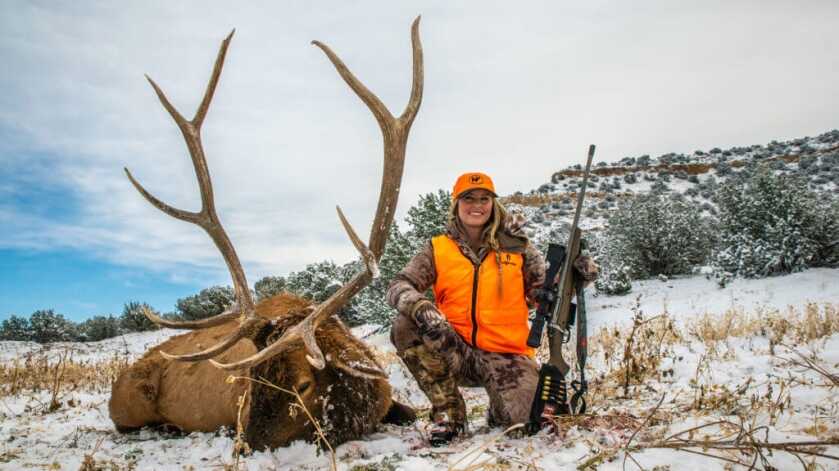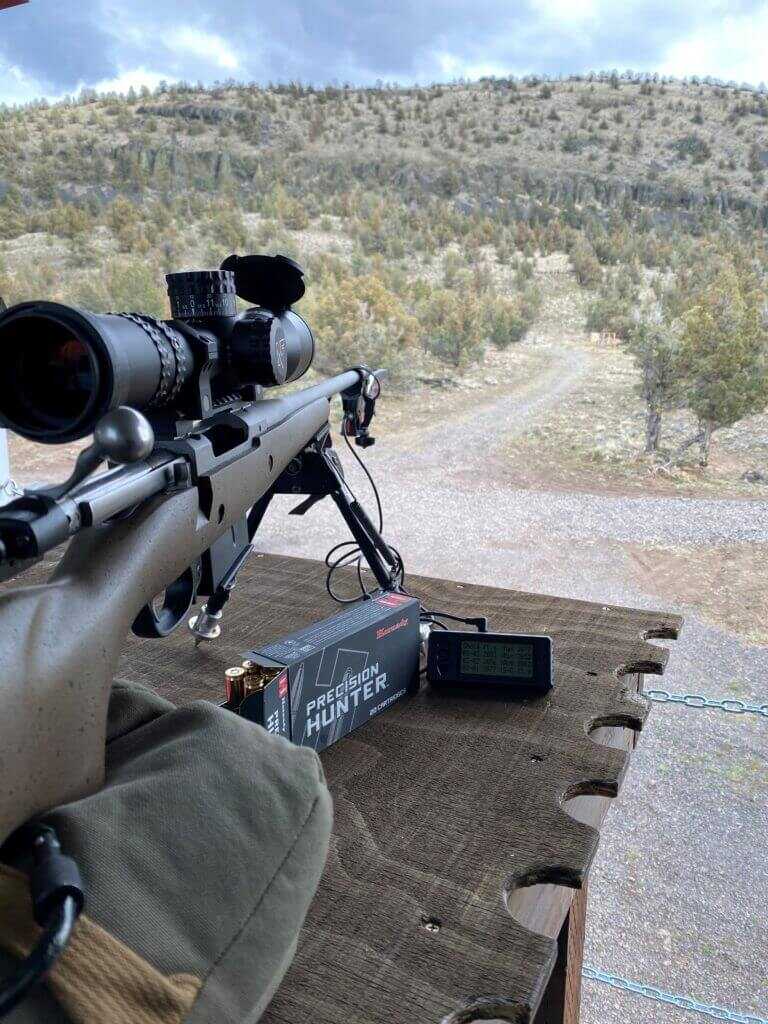
The hunts that we have been planning for all year, or perhaps in some cases, our entire life are right in front of us. We all head afield with the hopes of making that shot of a lifetime and notching our tag. And, there is nothing worse than leaving the field with a miss under our belt. Being familiar with your equipment, how it operates and fits, will give you the confidence to head afield and have a positive hunting experience.
The Rifle

The caliber of your hunting rifle needs to be able to deliver terminal performance for the size of game that you are pursuing at the range that you anticipate making shots from. Historically, many hunters have chosen to hunt large, heavy-boned animals, like elk, with a 300 Win Mag. It is hard to argue the effectiveness of this cartridge on big game animals, however, the drawback is that the aggressive recoil from this cartridge makes self-spotting shots and subsequent follow-up shots more difficult. Plus shooting this cartridge can be slightly punishing with a lightweight hunting rifle, especially if you are a small person like me.
A general rule of thumb has been the higher the caliber, the bigger the game you can pursue with that caliber. However, the evolution of firearms and cartridges is continuous and the performance aspects in modern day cartridges and ballistics should not be overlooked. The introduction of the 6.5 PRC has transformed the hunting market with its low recoil characteristics, fast velocity, and excellent ballistic coefficient.
My Personal Testimony:
Shooting the Ruger Long Range Hunter, with factory Hornady 143 grain Precision Hunter ammunition, my average muzzle velocity is 2862 fps. with a standard deviation of only 13 fps from a 22” barrel. For those that hand-load, this cartridge can be super charged to gain velocities up to 3200 fps.
At the range, I confirmed my data out to 840 yards with the big bonus being that at distance, I could self-spot the majority of my impacts on the target. When compared to the 300 Win Mag, the 6.5 PRC has around 60% LESS recoil with similar performance characteristics.
The speed from the 6.5 PRC delivers super flat trajectories that perform well beyond standard hunting distances. The high BC’s on the Hornady Precision Hunter Ammunition (G1- .625 and G7- .315) mean that this cartridge/bullet combination is going to overcome the effects of wind drift efficiently in mountain conditions lending itself to more confidence in less than ideal conditions.
Watch this episode of Pursue The Wild, to see for yourself the hit that the 6.5 PRC delivers at 450 yards on a bull elk.
Rifle Fit
A poorly fitted rifle makes it difficult to find a natural place behind the rifle. This can lead to frustration due to the shooter’s inability to mount the rifle consistently every time they get into a shooting position. This lack of repeatability diminishes downrange accuracy and increases the likelihood for bad habits.
Length of Pull
The first thing to consider is the length of pull, meaning the distance from the trigger shoe to the buttstock of the rifle. Length of pull directly affects how the shooter mounts the rifle and their ability to operate the bolt.
If the rifle length of pull is too long, it may inhibit the shooter from operating the bolt, causing them to want to come off the rifle and “look” to operate the bolt. This diminishes the ability to stay on the gun, looking through the optic for a follow-up shot if one is necessary.
The rifle buttstock should fit naturally and consistently within the pocket of the shoulder without slipping into the armpit. Some rifle stocks have adjustable lengths of pull that easily adapt to multiple shooters. If your rifle stock isn’t adjustable, you can have your factory rifle stock cut down to fit.
Another option is purchasing a factory rifle that is designed with adjustability. The rise in participation of women and kids in both hunting and shooting sports has encouraged firearms manufacturers to produce rifles that will offer proper fit for smaller statured shooters. For example, many Ruger firearms have spacers that can easily be added or removed from the buttstock of the rifle.
A properly fitted rifle will allow the shooter to shoulder the rifle with the buttstock fitted into the pocket of the shoulder, provide a comfortable reach to easily operate the bolt, and reach the trigger for a clean trigger press.

Cheek Weld
The cheek weld is the position of the shooter’s cheek in relation to the rifle’s cheek comb that properly aligns the eye with the mounted optic in a relaxed position. Many hunting rifle stocks do not have adjustable cheek combs. This makes your scope mount selection critical. Mounting your optic in rings and bases that place your optic bell as close to the barrel as possible without touching it will help reduce the overall optic height.
Having a solid cheek weld that gives repeatable ocular alignment is going to improve the overall shooting experience. However, if that is not possible, I have found that I can get repeatable ocular alignment by using a chin weld by using the side of my jawbone on the rifle cheek comb.
Other options are to purchase an after-market cheek piece or the installation of a custom rifle stock.

Optic Eye Relief
One of the most important aspects of being accurate while shooting a rifle is having proper eye relief for the intended shooter. The optic eye relief is the distance the eye must be from the scope ocular lens in order to obtain a full field of view which may vary from person to person depending on their size. Proper eye relief is going to equate to the shooter being able to shoulder the rifle in nearly any position and naturally have a full field of view while looking through the scope.
If the shooter shoulders a rifle and has to adjust their head either forward or backward to eliminate shadowing within the scope, then the eye relief is not properly set for them. Sometimes, it can be so bad that all the shooter sees is a blackout. That is not a good scenario in a high-pressure hunting situation for the shooter adding pressure to an already intense moment.
In my experience, it is less than ideal to have a male parent or spouse mount and zero a riflescope on the behalf of a woman or child. Ideally, the scope is mounted on the rifle with the intended shooter present or by the actual user, so that the scope can be positioned within the rings to provide proper eye relief.
To determine the correct eye relief, set the riflescope to the maximum magnification and have the shooter shoulder the rifle and set their natural cheek weld with their eyes closed. Once they are set in a natural position, have them open their eyes. Ideally, they have a full field of view in the scope without moving their head.
If needed, the scope should be repositioned within the rings and adjusted either forwards or backward until a full field of view is established using this process. This is a quick adjustment will greatly increase the enjoyment and accuracy while shooting the rifle.
Ammunition

With there being many types of bullets on the market, hunters need to pay attention to how a bullet is constructed and select the bullet that is designed for the game that they are pursuing. Selecting an appropriate cartridge, bullet type, bullet weight, and corresponding ballistic coefficient are all important. What hunters are looking for is a well-constructed, reliable bullet that will expand enough to carve out a devastating wound channel while retaining enough weight to ensure adequate penetration to reach vital organs after passing through hide, bone, and muscle.
It is important for most hunting scenarios that the bullet delivers accuracy and terminal performance at close to medium ranges say 100-400 yards where velocities are still high, and also performs reliably at extended ranges beyond 400 yards.
What we don’t want is at close range where velocity is high having the bullet uncontrollably expand or blow up on contact with bone and fail to reach vital organs or simply fail to expand at all. Reliable expansion at any distance and velocity is a must.
Let’s talk about ballistic coefficient (BC) and why a high BC bullet is important while hunting. The higher the BC a bullet has, the more capable that bullet will be of retaining its velocity and energy over longer distances. What that means for hunters is that it is going to have a flatter trajectory, meaning that the bullet will drop less during flight to the intended target. Also, with a high BC it will be less susceptible to the effects of wind drift. This is really important on mountain hunts with shifty winds.
The bullet’s impact energy is affected by the BC as well. A bullet with a higher BC will arrive at the target retaining more energy allowing it to punch through heavy bone in order to reach vital organs. Each caliber is going to offer bullets in a variety of weights. How much your bullet weighs will have a direct effect on velocity and BC. Cartridges have limitations in energy, so they can either push a light bullet fast or a heavy bullet more slowly. Generally speaking, the bigger the game, the heavier the bullet you will want to use.
The reason to choose a heavy bullet is due to their energy retention characteristics at longer distances and ability to drift less in the wind. Heavier bullets penetrate better due to their greater mass and higher sectional densities.
Conclusion

Selecting a cartridge and rifle combination that is going to have excellent performance characteristics as well as the flexibility to fit anyone has become much easier making shooting and hunting even more fun and successful for the entire family.
The success of any hunt falls on the shoulders of the shooter and their ability to properly place the bullet with accuracy. As marksmen and hunters, we want to be certain that we have done everything possible to make that first shot count. Having a well-fitted weapon system and good ammunition leaves it only up to the marksman to make it happen.
Get out and practice from realistic shooting positions that you are likely to encounter during your hunt. This type of practice will prepare you for possible hunting scenarios that you may encounter while afield and also help you identify which shot opportunities you can ethically take and others that you should pass on and wait for a better opportunity.

